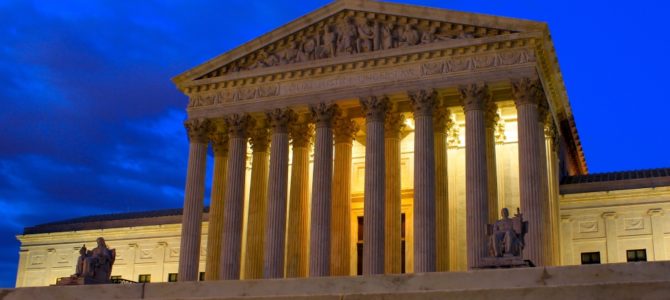
On August 16, the Human Rights Campaign denounced the Trump administration for giving a “green light” to discriminate against transgender workers by interpreting federal law such that “sex” means biological sex instead of gender identity. The Obama administration had done the opposite, and was reversed after Donald Trump became president.
HRC Legal Director Sarah Warbelow said of pending litigation against this return to pre-Obama legal understandings, “There can be no justification for such a narrow interpretation of the term ‘sex.’ Our community will not be silent, and we will not be erased.” The issue revolves around Title VII of the Civil Rights Act of 1964. The administration has argued, “Title VII prohibits treating an individual less favorably than similarly situated individuals of the opposite sex,” but does not specifically separate gender identity from biological sex.
This coming October, the Supreme Court is set to review three cases that could determine how future federal law handles discrimination protections for LGBT workers. HRC’s comments regard a case in which a male employee was fired as the employee moved from wearing male clothing to wearing female clothing at work.
The case, EEOC v. Harris Funeral Homes, is complicated. It involves policies based on biological sex as well as concerns over religious freedom.
From 2003 until 2013, Harris Funeral Homes employed a person who now prefers the name Aimee Stephens. Beginning as an apprentice, Stephens worked up to becoming funeral director and embalmer before choosing to identify as the opposite sex. According to the complaint, several weeks after Stephens informed Harris that Stephens would appear at work in female clothing, the employer chose to terminate Stephens’ contract.
The owners were concerned that Stephens would now be sharing the home’s single-sex bathroom with female employees and clients. Additionally, as Stephens would now be dressing in female clothing while still possessing masculine physical features (Stephens had not undergone any surgery), the owners felt Stephens’ appearance distracted grieving families and undermined their religious values. Ownership felt “there is no way that” Ms. Stephens “would be able to present in such a way that it would not be obvious that it [Stephens] was [a man].”
The briefing states that Harris owner “Rost has stated that he “believe[s] that the Bible teaches that a person’s sex is an immutable God-given gift,” and he would “violat[e] God’s commands” by “permit[ting] one of [Harris Homes’] funeral directors to deny their sex while acting as a representative of [the] organization” or by permitting a funeral director of either sex to “wear the uniform for” funeral directors of the opposite sex “at work.” The legal argument is that, because Stephens complied with the regulations for male and female dress and identifies as a woman, what took place was discrimination based on sex.
The case is one of several that LGBT advocates hope will broaden the definition of sex within civil rights law to include gender identity. The Washington Blade described the briefing this way: “the Trump administration urged the Supreme Court late Friday to issue a ruling that federal civil rights law doesn’t cover discrimination based on gender identity, therefore firing workers for being transgender is perfectly legal.”
While a strong case can be made that this funeral home discriminated against a long-term employee based exclusively on that employee’s transgender behavior, the argument that this violates “sex discrimination” is problematic. As the briefing argued, “Here, Harris Funeral Homes would have responded to a female employee who insisted on dressing as a man while working with grieving families the same way it responded to Stephens. Because it does not disfavor one sex compared to the other, Harris does not discriminate based on sex.”
Yet, as Harris’ brief makes clear,
At all times, Harris has administered its dress code based on biological sex, not gender identity. Stephens does not challenge the dress code itself. Instead, Stephens says that it constitutes sex discrimination to apply a dress code based on biological sex rather than an employee’s internal sense of gender. Before this case, neither Tom nor Harris had been accused of workplace discrimination of any kind.
One could argue that preventing female employees from wearing clothing the owner thinks resembles “dressing as a man” could qualify as sex discrimination. If Stephens’ appearance had resembled traditionally male attire, it is also possible the owner’s religious objection would have resulted in the same outcome. The owner of Harris Funeral Home disputes this, saying he would have not have reached the same decision had Stephens “continued to conform to the dress code for male funeral directors while at work,” and that there would have been a similar issue if a female employee had refused to conform to the different female-specific dress code requirements.
The issue is whether LGBT advocates will accept a legal definition of “sex” and “gender identity” as distinct. If they choose to combine the two into a singular concept, then much of their advocacy for transgender rights and gay and lesbian legal protections will be severely undermined—so too would nearly all legal victories won for women. As detailed in an article titled, “The Equality Act Would Lead to the Death of Women’s Rights,” women’s rights are defined exclusively by their physical separation from men and the historically unfair treatment that many believe was the result of those physical differences.
In the same way, gays and lesbians fought for the law to treat two men or two women the same as one man and one woman. If gender identity overrides biological sex, there is no longer a legal case for “same-sex” protections or legal distinctions.
This would also put transgender rights at risk, as both medical transition and access to sex-segregated spaces require a distinct concept of biological sex. The pertinent question is how the law recognizes employee rights while someone becomes transgender, and if employers must accommodate gender expression in the workplace.
An adult has the legal right to modify his or her body with tattoos, piercings, hairstyles, and clothing choices in any way he or she chooses. Yet businesses also have the right to dictate dress codes for employees. But can an employer legally dictate a dress code for men and women and then discriminate against employees who technically follow those guidelines—except for the opposite sex?
The upcoming SCOTUS fights over these issues is about more than just employment law and LGBT protections. The outcome of this battle will affect many Americans.
The Trump administration clearly states that Title VII of the Civil Rights Act of 1964 does not include “gender identity” as protected under the word “sex.” The briefing states, “In 1964, the ordinary public meaning of ‘sex’ was biological sex. It did not encompass transgender status, which Stephens and the Sixth Circuit describe as a disconnect between an individual’s biological sex and gender identity.” Any change to this definition would require Congress to modify the definition of “sex” to include “gender identity” and so far, Congress hasn’t done so.
Where this all leads will be heavily influenced by the decisions provided by the Supreme Court on the issue. Until then, LGBT advocates should organize arguments about transgender employment protections separately from sex-based protections. Doing so will likely lead to better legal results that will not harm such a large swath of the population. Most LGBT advocates, however, seem bent on using the law to forcibly change the culture rather than just fighting to fill what they believe to be gaps in legal protections for LGBT Americans.









